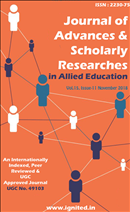Divisional Disparities in Haryana State
Understanding the Growing Divisional Disparities in Haryana State
Keywords:
Haryana State, divisional disparities, regional disparities, population, Census 2011, per capita income, literacy rates, health and education, banking and entertainment services, povertyAbstract
Haryana state is located in the Northern part of India and has New Delhi as its neighbour along with Punjab and Rajasthan. Haryana State came into existence on 1 November 1966. As per details from Census 2011, Haryana have population of 2.54 Crores, an increase from figure of 2.11 crores in 2001 census. Total population of Haryana as per 2011 census is 25,351,462 of which male and female are 13,494,734 and 11,856,728 respectively. One of the most complex problem of Haryana is that regional disparities are fast increasing. Some region are growing in their capacities while some others are remaining poor and backward. Regional disparities in Haryana have been an issue since its existence. Regional disparities may be due to natural resources, Economic Resources, Geographical resources or man-made resources. Regional disparities means wide gap in per capita income, literacy rates, availability of health and education and education and banking and entertainment services among the different region. Increase in regional disparities leads to poverty, dissatisfaction and violence among the youth. Aggregate poverty can be removed by reducing the all types of Regional disparities in Haryana.Published
2018-11-01
How to Cite
[1]
“Divisional Disparities in Haryana State: Understanding the Growing Divisional Disparities in Haryana State”, JASRAE, vol. 15, no. 11, pp. 503–506, Nov. 2018, Accessed: Jul. 08, 2024. [Online]. Available: https://ignited.in/jasrae/article/view/9096
Issue
Section
Articles
How to Cite
[1]
“Divisional Disparities in Haryana State: Understanding the Growing Divisional Disparities in Haryana State”, JASRAE, vol. 15, no. 11, pp. 503–506, Nov. 2018, Accessed: Jul. 08, 2024. [Online]. Available: https://ignited.in/jasrae/article/view/9096








